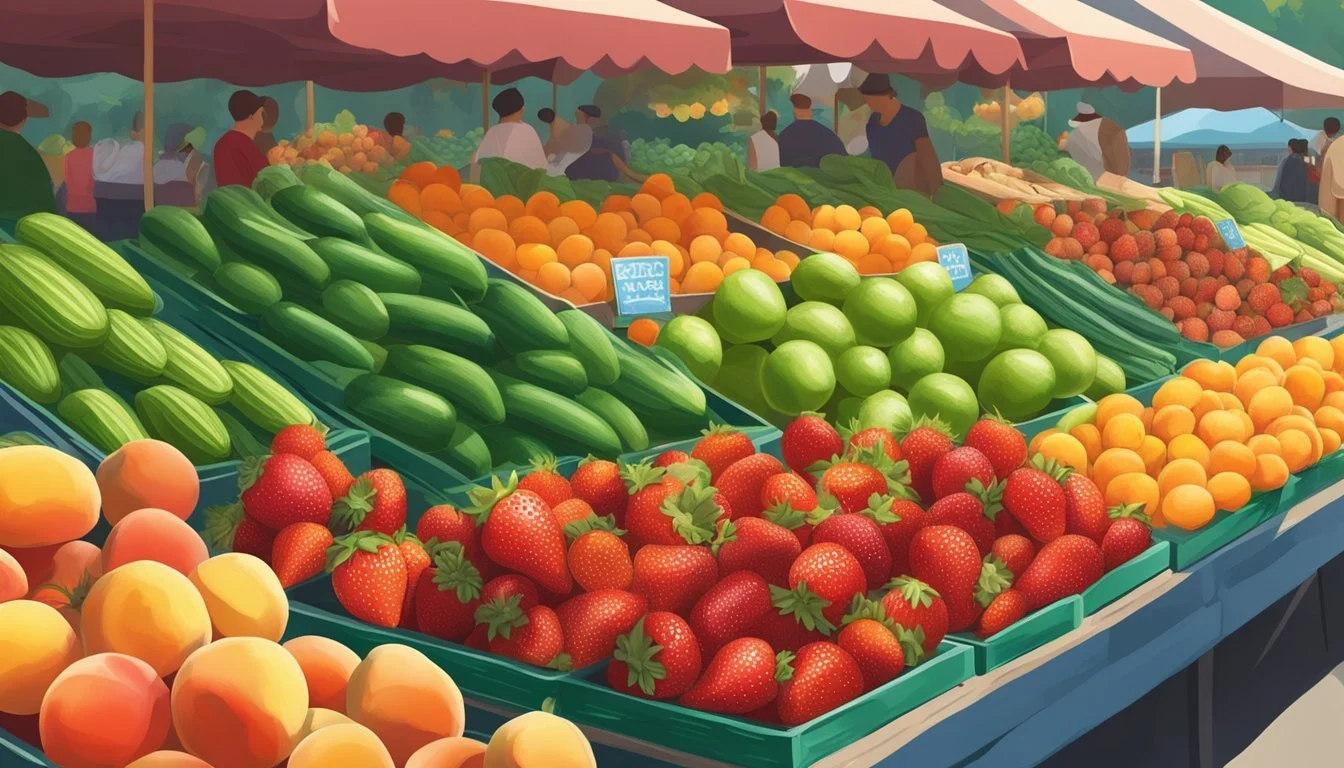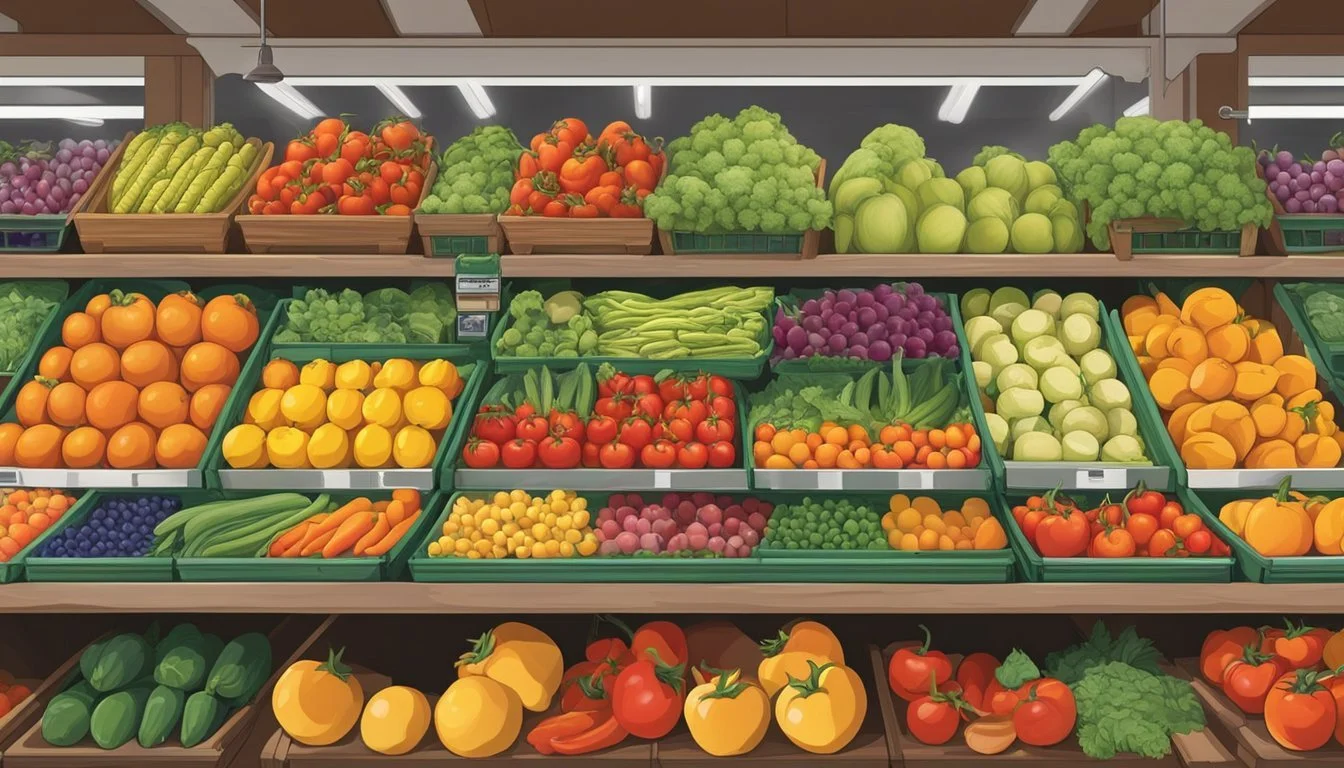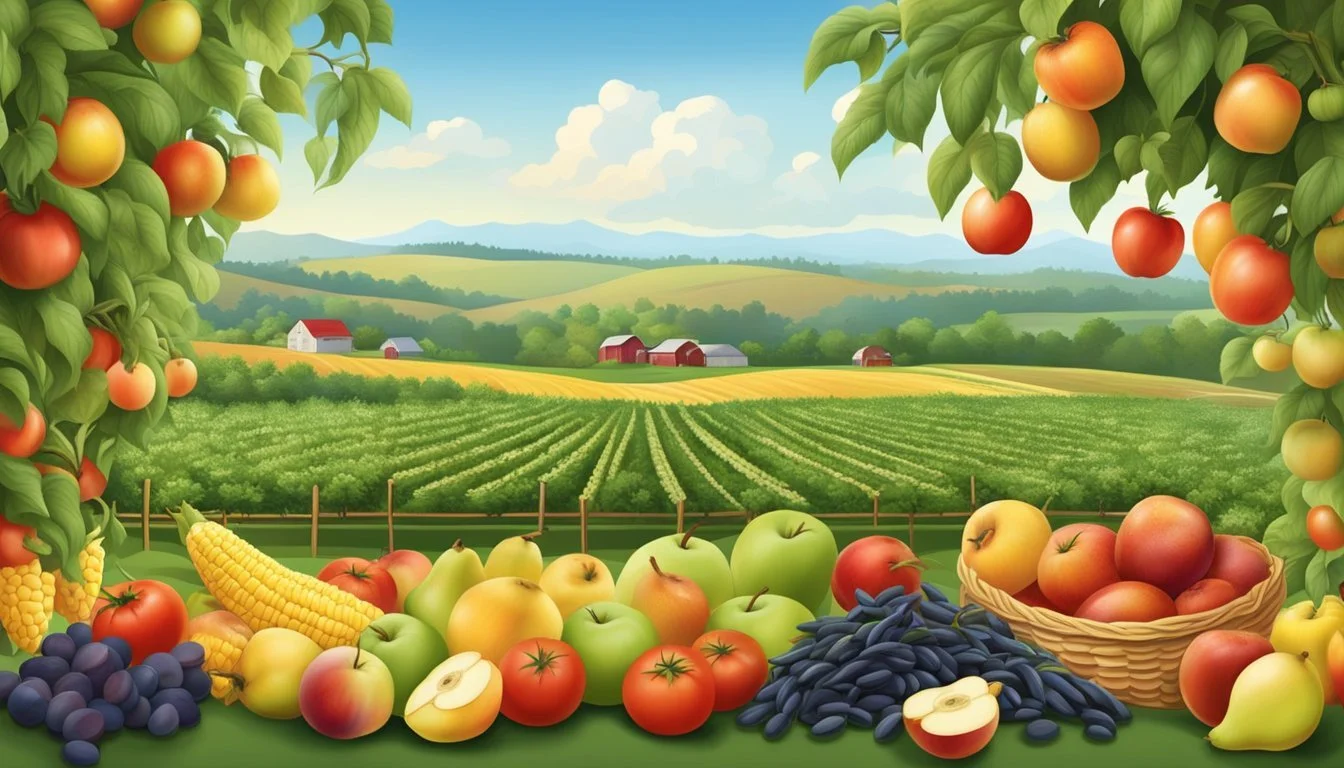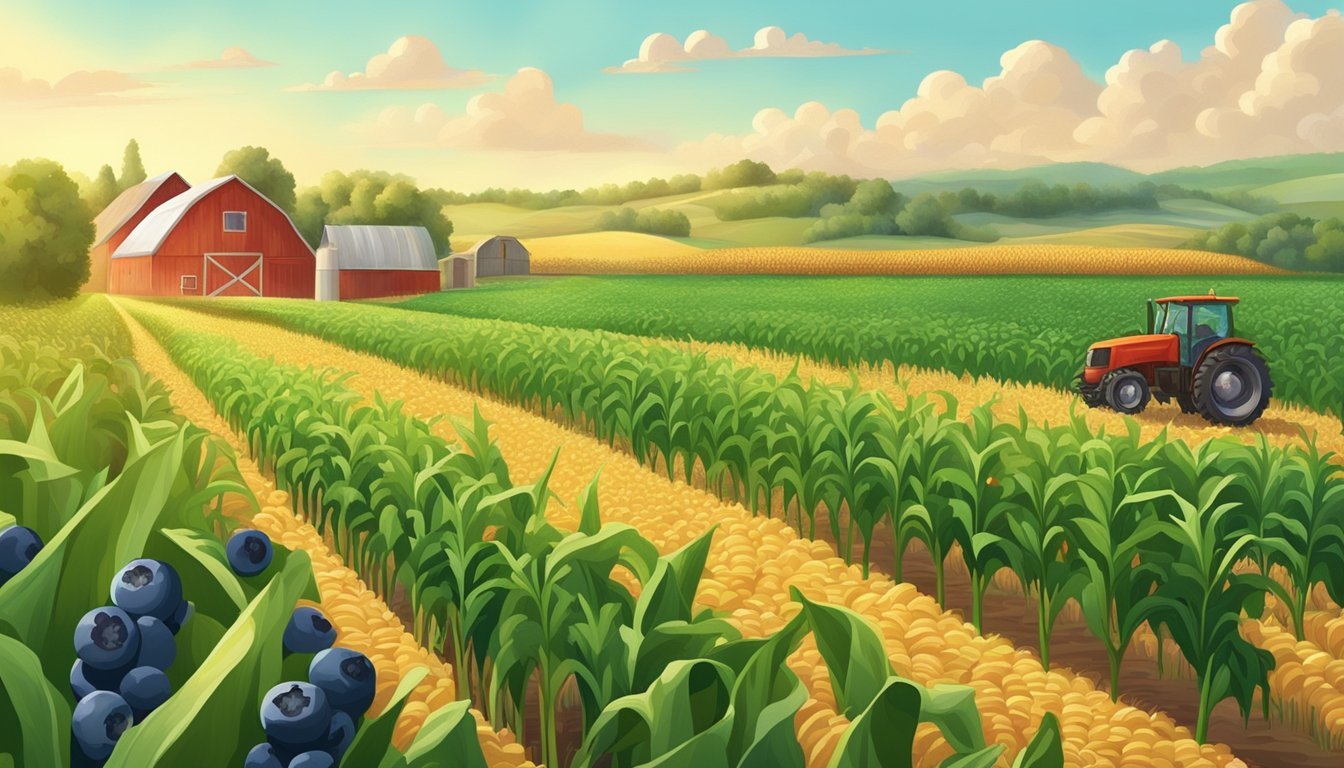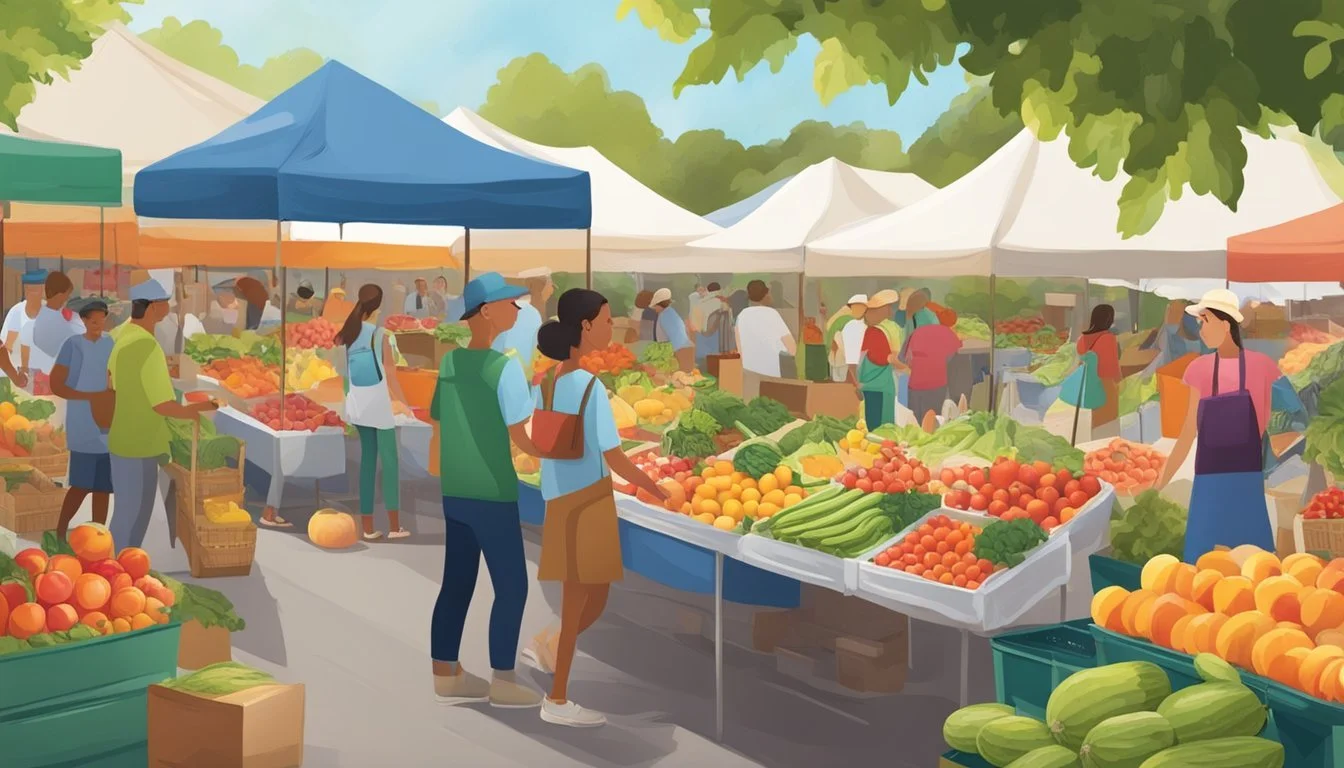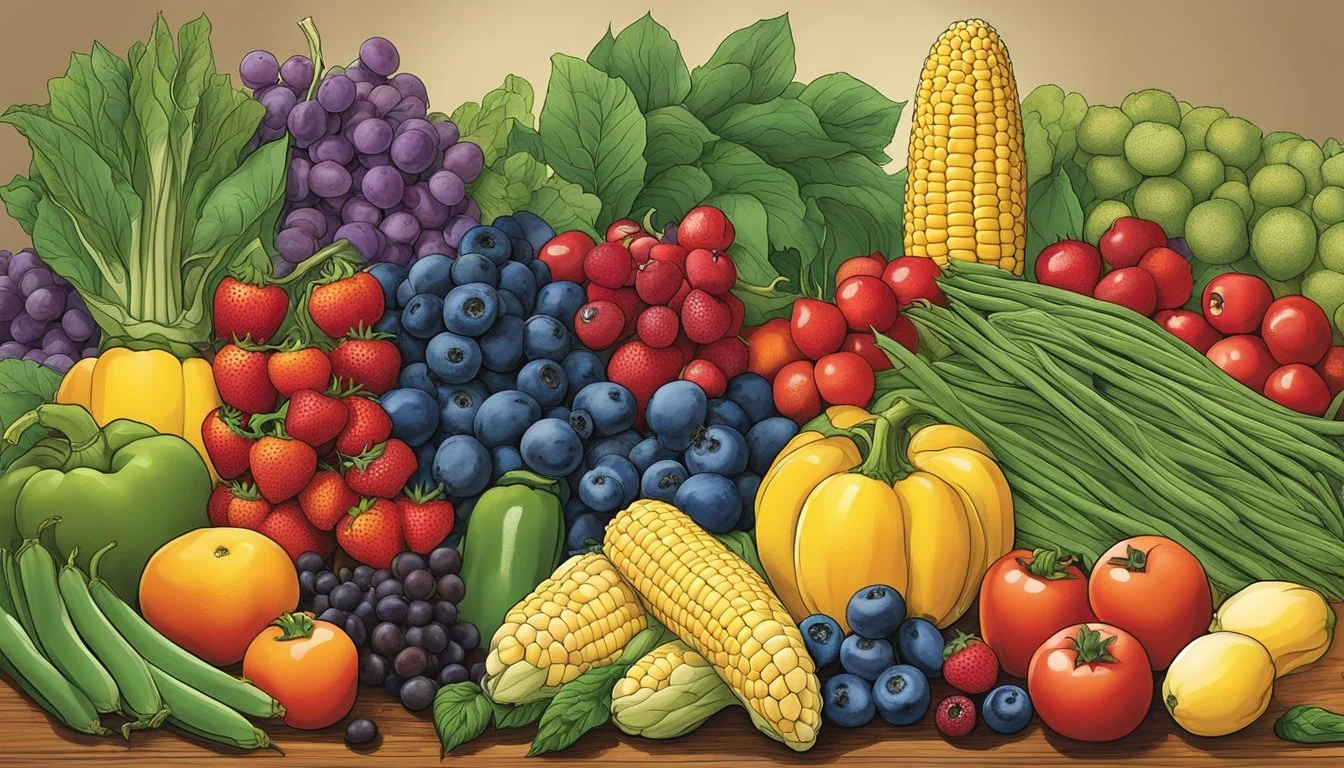Minnesota Seasonal Fruit & Vegetables in August
Your Guide to Fresh Produce
This Article is Part of our Minnesota Seasonal Fruit & Veg Calendar
Minnesota's bountiful harvest peaks in August, presenting a diverse palette of fresh fruits and vegetables. Amid the summer's warmth, local farms and gardens yield a plethora of produce that captures the essence of the season's flavor. The variety available ranges from the sweetness of blueberries (how long do blueberries last?) to the earthy robustness of root vegetables, all at their prime during this month. Food enthusiasts and home cooks alike revel in the abundance that the summer harvest brings, with farm stands and markets showcasing the vibrant hues and fresh flavors of Minnesota's August produce.
The region takes pride in a selection of seasonal fruit and vegetables that cater to every palate. Cucumbers (how long do cucumbers last?), known for their crisp texture, are picked at the height of their freshness along with the luscious blueberries, which typically wrap up their season by mid-August. Carrots and green beans offer crunch and flavor, while a variety of greens like kale and lettuce continue to add verdant freshness to summer dishes. The fleshy cantaloupes (how long does cantaloupe last?), a treat to both the eyes and the taste, arrive in August, boasting their juicy sweetness that is perfect for hot summer days.
With an embrace of the farm-to-table movement, Minnesotans have a profound appreciation for the local harvest, ensuring that the fruits and vegetables they consume are as nutritious as they are flavorful. This guide to August's harvest not only underscores the importance of seasonal eating but also champions the local agricultural community. As the summer reaches its zenith, Minnesota's fertile land generously provides a cornucopia of fruit and vegetables, offering a taste of the state's agricultural expertise and natural splendor.
Seasonal Produce Overview
In Minnesota, the month of August is an abundant time for garden enthusiasts and market-goers alike. The summer warmth cultivates a diverse array of fresh produce ripe for the picking.
Vegetables thrive in this period, with an assortment of types reaching their peak. Among these are:
Cauliflower (how long does cauliflower last?)
Celery (how long does celery last?)
Corn
Cucumbers
Eggplant (What wine goes well with eggplant?)
Green Beans
Garlic
These vegetables are not only fresh but also boast a richness of flavor, a product of the local soil and climate conditions.
The season also offers a variety of summer fruits that include:
Grapes
Grapes are particularly noteworthy as they transition into perfect ripeness come September. The markets in Minnesota prominently feature these fruits, known for their burst of natural sweetness.
For those frequenting farmers' markets or perhaps nurturing their own garden, August stands as a rewarding and fruitful period. The combination of long days and warm temperatures supports the growth of robust produce. Gardeners are often at the peak of their harvest while markets overflow with the bounty of the season.
The verdant growth of summer provides consumers with an excellent opportunity to incorporate fresh, locally-sourced vegetables and fruits into their diets, supporting both their health and the local agricultural community.
Fruits
In August, Minnesota bursts with a bountiful variety of seasonal fruits, offering an explosion of flavors ripe for the picking. These summer treasures are highly anticipated at local markets, and a guide to what’s fresh can enhance one’s shopping experience.
Berries
August is peak season for berries in Minnesota. Fresh blueberries and raspberries can be found gracing farmers' market stands, while blackberries (how long do blackberries last?) start to make their appearance, each offering a rich, tangy sweetness perfect for summer desserts or healthy snacking.
Blueberries: Packed with antioxidants and flavor.
Raspberries: Delicate and versatile for recipes.
Blackberries: Lush and deeply hued, signaling their readiness.
Stone Fruits
Stone fruits thrive in the summer warmth, and Minnesota’s August harvest includes juicy plums, peaches, and nectarines. Each fruit's flesh encases a hard pit, giving them the name "stone fruit."
Plums: Diverse in color and taste, they can be sweet or tart.
Peaches: Known for their fuzzy skin and sweet, juicy flesh.
Nectarines: Smooth-skinned and can be eaten firm or soft.
Melons
Melons such as watermelon, cantaloupe, and honeydew are synonymous with summer refreshment. These fruits become ripe under the August sun, offering a hydrating respite during Minnesota's warmest days.
Watermelon: Quintessential summer fruit with a high water content.
Cantaloupe: Netted skin and a sweet, musky aroma when ripe.
Honeydew: Subtle sweetness with a pale green flesh.
Others
Apples start to signal the coming fall, but certain early varieties are ready in August. Grapes also begin to sweeten on the vine during this time, hinting at the impending grape harvests.
Apples: Early varieties may be tart, making them ideal for cooking.
Grapes: Begin to ripen, soon ready for both eating fresh and winemaking.
Vegetables
August in Minnesota brings an abundant harvest from the garden, offering an array of fresh vegetables that thrive in the warm summer climate. This guide helps identify which vegetables are in peak season.
Leafy Greens
Leafy greens such as kale, lettuce, spinach, and Swiss chard are thriving in August. These greens require consistent watering to maintain their tender leaves, which are ideal for fresh salads.
Kale: Full sun and well-drained soil ensure a robust harvest.
Spinach: Prefers cooler nights, so keep soil moist.
Swiss Chard: Resilient to heat if provided with enough water.
Root Vegetables
Root crops like beets, carrots, garlic, onions, radishes, and turnips are reaching maturity this month. They store well and can be used in a variety of dishes for added flavor and nutrition.
Beets: Earthy flavor, perfect for roasting or pickling.
Carrots: Deep watering helps develop their sweetness.
Nightshades
August is the month where nightshades such as eggplant, tomatoes, bell peppers, and cherry tomatoes are at their best. These vegetables need warm soil and plenty of sunlight to ripen to perfection.
Tomatoes: Stake or cage plants to support heavy fruits.
Bell Peppers: Harvest when firm and brightly colored.
Squashes
Summer squash and zucchini are harvested frequently in August to keep plants productive. Monitor for signs of pumpkins, which signal the approaching fall season.
Zucchini: Harvest while small for best texture.
Pumpkins: Developing; usually not ready until fall.
Legumes
Legumes like beans, green beans, peas, and shelling beans add a fresh crunch to the dinner plate and fix nitrogen in the soil, benefiting the garden ecosystem.
Green Beans: Pick regularly to extend the harvest.
Peas: Provide support for climbing varieties.
By August, a gardener's efforts are rewarded with a colorful selection of nutritious vegetables to enjoy.
Herbs and Aromatics
In the heart of summer, Minnesota’s thriving herb gardens are a testament to the state’s fertile soil and ideal growing conditions during this time. They are particularly generous in August, providing a plethora of aromatic plants that add both flavor and fragrance to a variety of dishes.
Basil takes a prominent place in Minnesota’s herb collection. With its lush, green leaves and distinct peppery flavor, it is a favorite for many gardeners and chefs. Basil thrives in the warm August weather, and its uses range from fresh pesto to a delightful complement in tomato-based dishes.
Mint is another herb that enjoys the summertime climate. It is known for its refreshing taste and versatility. Mint varieties, such as spearmint and peppermint, lend themselves to both sweet and savory applications including beverages, desserts, and salads.
The herb assortment also includes other staples, such as:
Parsley: a bright, clean flavor perfect for garnishing and adding a touch of green.
Cilantro: with its pungent, citrus-like taste, it’s essential in salsas and many Asian cuisines.
Dill: whose feathery fronds contribute a soft, anise-like essence to seafood dishes (What wine goes well with seafood dishes?) and pickles.
Not only are these herbs a joy for home cooks but they also contribute significantly to local farmers' markets. Parsnips, while not an herb, are worth noting as they start to make their appearance later in the season, valued for their earthy sweetness in stews and roasted vegetable (What wine goes well with roasted vegetables?) medleys.
By incorporating these fresh herbs, Minnesotans celebrate the full spectrum of flavors in their regional produce, elevating the culinary experience with every dish.
Preparation and Usage
August in Minnesota boasts a varied selection of fresh produce that can be used in numerous culinary applications. Vegetables like broccoli and cauliflower thrive during this month and are versatile in the kitchen. They can be roasted to intensify their natural flavors, stirred into salads, or blended into sauces or pesto for a flavorful twist.
Broccoli and cauliflower preparation typically involves:
Washing thoroughly to remove any dirt.
Cutting into florets for even cooking.
Blending raw for salads or pesto.
Eggplant, another seasonal vegetable, is the base in a variety of dishes. When making Baba Ganoush, one roasts the eggplant to a soft, creamy texture before blending it with other ingredients. Alternatively, Eggplant Parmesan (What wine goes well with eggplant parmesan?) layers slices of breaded and fried eggplant with cheese and tomato sauce.
To prepare eggplant:
Slice or dice depending on the recipe.
Salt to remove bitterness, then rinse and pat dry.
Roast, grill, or incorporate into casseroles.
Fruits available this month like blueberries and cantaloupes lend themselves well to sweet applications. They can be eaten fresh, used in desserts, or even canned for preservation.
Blueberry and cantaloupe preparation tips include:
Blueberries: Rinse gently, then use fresh or in baking.
Cantaloupes: Peel, de-seed, and slice. Ideal for fresh fruit salads (how long do fresh fruit salads last?) or as a sweet puree.
Whether creating savory dishes or sweet treats, chefs emphasize using these ingredients at their peak for maximum flavor and nutritional value.
Shopping Guide
August in Minnesota offers a bounty of locally grown fruits and vegetables available at various shopping points such as farmers markets, grocery stores, and pick-your-own farms. Shopping for local produce not only supports the Minnesota economy but also ensures fresh, nutrient-rich foods.
Farmers Markets: These are prime spots for the freshest seasonal selection. Shoppers can find a plethora of produce, from leafy greens to ripe fruits. Most notable are stalls tagged with 'Minnesota Grown' which guarantees locally sourced and seasonal goods.
Vegetables:
Cauliflower (August–November)
Celery (August–October)
Cucumbers (July–October)
Garlic (August–November)
Green Beans (July–September)
Greens (May–October)
Fruits:
Blackberries (through August)
Blueberries (July–mid August)
Grapes (starting September)
Grocery Stores: When shopping here, consumers should look for 'Minnesota Grown' labels to determine local produce. Selections might include greenhouse-grown foods which extend common seasons.
Pick-Your-Own Farms: These are perfect for an engaged experience. Blueberries can still be picked in the beginning of August. It’s a fun way to directly support local farms and take home the freshest fruit possible.
When purchasing produce, choose items that are free from blemishes and feel firm to the touch. Storage is crucial; most vegetables should be refrigerated while some fruits like grapes may last longer when kept in a cool place. For the best eating experience, consume fresh produce soon after purchase to enjoy their full flavor and nutritional benefits.
Seasonal Recipes
August in Minnesota brings a bounty of fresh produce that is perfect for creating delicious, seasonal recipes. From the sweet and tangy flavors of fruit salads and berry pies to the savory depth of roasted vegetables and eggplant parmesan, the summer harvest offers an array of ingredients for the kitchen.
Salads
Mango Salsa: A refreshing combination of fresh, ripe mangoes mixed with bell peppers, onions, and cilantro. It serves as an excellent topping for grilled fish or chicken.
Green Bean Salad: Toss crisp, locally-harvested green beans with a balsamic vinaigrette and topped with slivered almonds for a crunch.
Main Dishes
Eggplant Parmesan: Breaded and baked slices of eggplant layered with homemade tomato sauce and mozzarella, then broiled to melty perfection.
Roasted Summer Squash: Season slices of summer squash with herbs and olive oil, then roast until golden brown for a simple yet flavorful side dish.
Desserts
Berry Pie: Combine a mixture of fresh August berries like blueberries and raspberries in a flaky pastry crust, bake until bubbly, and serve warm.
Parsnip Cookies: Incorporate grated parsnips into cookie dough for a unique twist on a classic dessert, offering a subtle, sweet-spiced flavor.
Preserving
Canned Green Beans: Preserve the taste of summer by canning green beans to enjoy their crispness all year round.
Jams: Create jams from the abundance of fruits such as raspberries and blackberries to capture the sweet essence of August.
Pickled Vegetables: (What wine goes well with pickled vegetables?) Pickle a variety of vegetables like cucumbers and carrots to add a tangy zing to meals.
Health Benefits
Minnesotans relish August for its abundance of fresh produce, offering a range of health benefits due to the high content of vitamins and antioxidants. Consuming fruits and vegetables during their peak seasons ensures maximum nutrient density and flavor.
Blueberries, available through mid-August, are packed with powerful antioxidants that support the immune system and may help in preventing chronic diseases. Their high Vitamin C content contributes to the overall health of skin and tendons and aides in the absorption of iron from plant-based foods.
Watermelon, a classic August fruit, is not just refreshing but also contains amino acids that aid blood circulation and potentially lower blood pressure. This fruit is also significantly hydrating and low in calories, making it a summer staple.
Broccoli, which is harvested through October, comes loaded with fiber aiding digestion and is rich in both Vitamin C and antioxidants. These nutrients work together to support the body’s immune response and protect against cellular damage.
Vegetable Nutrient Benefits Cabbage High in Vitamin C and antioxidants, cabbage is another August vegetable that can enhance the body's immunity and assist in inflammation reduction. Cauliflower Another versatile vegetable, cauliflower provides a good source of choline, vital for brain health and full of antioxidants.
Eating seasonally also encourages a varied diet, which is beneficial for gut health and reduces the risk of developing food intolerances. Seasonal produce like these tends to be fresher, more flavorful, and may also contain more nutrients than out-of-season or stored fruits and vegetables. As such, they play an important role in a balanced diet.
Growing and Harvesting
August in Minnesota is a prime time for backyard gardeners and commercial growers alike to harvest a variety of fruits and vegetables. The University of Minnesota and the Minnesota Department of Agriculture offer resources for best practices to ensure a bountiful harvest.
During this month, watering is crucial as the summer heat can stress plants. A rule of thumb recommended is about an inch of water per week, either from rain or manual watering, to maintain healthy growth.
Vegetables to Harvest:
Cauliflower: Ready from August through November.
Celery: August through October is the ideal time.
Chard: Can be harvested from July through September.
Corn: Mid-June to mid-August offers the sweetest ears.
Cucumbers: July through mid-October is the cucumber season.
Eggplant: July up until mid-October is perfect for harvesting.
Garlic: It can be harvested from August through November.
Green Beans: July through September is the prime time for beans.
Fruits to Note:
Grapes: These typically become ripe in September.
Apples: While some early varieties might be ready, most mature in fall.
For those planting in late summer, the preparation for the fall harvest begins now. Leafy greens like lettuce, kale, and spinach can be planted in early August for a September harvest. Weeding remains important throughout August to decrease competition for nutrients and water.
Gardeners can refer to the University of Minnesota Extension for detailed growing guides and contact the Minnesota Department of Agriculture for additional support and resources, ensuring that the transition from the growing season into the fall is smooth and productive.
Community and Events
In Minnesota, August is a vibrant month for community activities centered around the state's seasonal produce. Farmers markets thrive during this period, offering a wide array of fresh, Minnesota Grown fruits and vegetables. Regular events at these markets include cooking demonstrations, tastings, and workshops that educate the community on the benefits of local produce consumption.
The Minnesota State Fair, an iconic event, often showcases the best in agricultural produce. Visitors can expect exhibition stands filled with the freshest seasonal offerings, and competitions where local farms display their finest produce.
Local farms sometimes host 'pick your own' events. It's a chance for the public to come and harvest their own selection of fresh produce straight from the source. This not only supports the farm but also connects individuals to the food they eat.
The Minnesota State Horticultural Society often lists events in August like the "Garden Club of Minneapolis - New Plants and Perennials for 2024", which, while not exclusively about produce, contributes to the community's gardening knowledge.
Event Type Description Locations More Info Farmers Markets Fresh local produce, demonstrations, tastings Statewide Minnesota Grown Directory Minnesota State Fair Exhibitions, competitions Minnesota Fairgrounds State Fair Events Pick Your Own Self-harvesting experience Participating farms Local Farm Listings Educational Workshops Gardening and new plants Horticultural Society Event Calendar
By engaging in these events, communities foster a stronger connection to Minnesota's agricultural roots, promote sustainable practices, and celebrate the bounty of the season.
Sustainability and Local Impact
In Minnesota, the local food movement gains considerable traction in August, spotlighting sustainability and the regional impact of consuming local produce. Local farms benefit from the synergy of ideal growing conditions and consumer demand for fresh, in-season fruits and vegetables.
Local Farming Practices: Growers in Minnesota often employ sustainable farming techniques that contribute positively to the environment. These methods include crop rotation, natural pest management, and reduced use of chemical fertilizers, which in turn supports the health of local ecosystems.
Minnesota Department of Agriculture supports these efforts through various initiatives aimed at bolstering the market for locally-grown produce. By assisting local farmers in adopting sustainable practices, the department helps to minimize the carbon footprint associated with long-distance transportation of food products.
Seasonal Availability
August represents a peak season for an array of produce in Minnesota:
Fruits: Blueberries, Cantaloupes
Vegetables: Broccoli, Brussels Sprouts, Cabbage, Carrots, Cauliflower, Celery, Chard
Consuming this locally and organically grown produce can reduce environmental impact as the distance from farm to table is decreased, leading to lower greenhouse gas emissions.
Sustainable Consumer Choices: Individuals in Minnesota can support sustainability by engaging with their local farms either directly or through markets, fostering a connection between consumers and growers. This relationship not only supports the local economy but also encourages more environmentally mindful food production and consumption.
Marketing and Advertising
In August, Minnesota's fruitful bounty takes center stage, offering an array of fresh, locally grown produce. Minnesota Grown provides a pivotal resource for consumers seeking information on seasonal fruits and vegetables available in the state. Their branding plays a crucial role in the marketing strategies for farmers and vendors alike, emphasizing the value of supporting local agriculture.
Producers and marketers focus their advertising around the abundance of August crops like corn, tomatoes, and cucumbers. They often employ a mix of traditional and digital media to reach their audience. Print ads in local publications, combined with dynamic social media campaigns, showcase the ripe produce ready for harvest.
Farmers markets capitalize on the seasonal peak by distributing the Minnesota Grown Guide, which includes listings of local markets and the seasonal availability of produce. This guide acts as a marketing tool to draw attention to the locally produced fruits and vegetables and supports the farmers who grow them by guiding customers directly to their booths.
Here's an outline of common marketing strategies utilized in August:
Promotion Channels:
Local newspaper and magazine ads
Social media posts and ads
Radio spots
Marketing Materials:
Minnesota Grown Guide
Flyers and banners at markets
Email newsletters
The presence of farmers markets themselves serves as a live advertisement for Minnesota agriculture. Vendors often create visually appealing displays that entice market-goers, turning a weekend market visit into both a shopping excursion and a community event. These experiences reinforce the message of the ads and guides: fresh, local produce is best.


